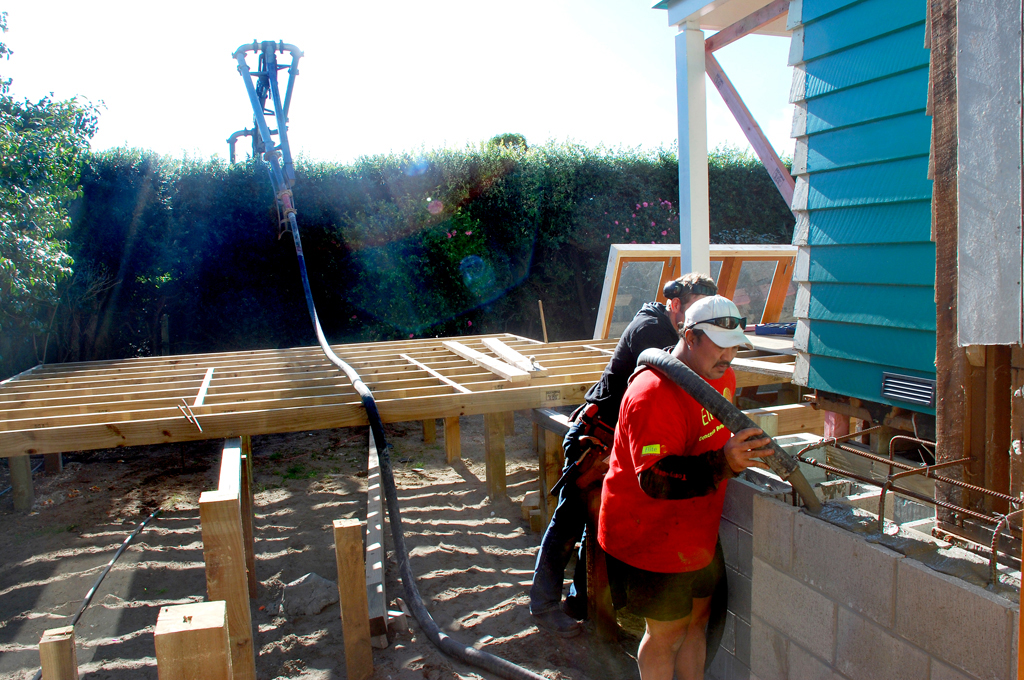Caution with concrete (Part 3)
22 Feb 2014, Prove Your Know How, Safety

Pumping concrete is often required in residential builds and, while builders don’t usually carry out the work themselves, ensuring the site remains safe during the process is everyone’s responsibility.
Pumping is an efficient method of moving and placing concrete, used in the manufacture of pre-cast and tilt-up panels, concrete formwork, slab construction, concrete paving and concrete spraying – and, like any process during a build, safety should be front of mind.
Everyone onsite has a responsibility to ensure safety measures are followed, while employers have obligations under the Health and Safety in Employment Act 1992 (the Act) to prevent harm to employees, contractors and others.
This article provides practical guidance about the health and safety issues of concrete pumping, with guidance for principals, employers, contractors and pump operators (employees or contractors) on how to meet their obligations to provide the safest working environment possible.
Overhead power lines and other electrical equipment
If a concrete placing boom is set up near aerial power lines, the principal and concrete pumping contractors should take all practicable steps to ensure workers are not harmed by the significant hazards faced when working near high-voltage electricity.
These include electrocution from direct contact with the lines, or arc flash, where a flashover of electric current leaves its intended path and travels through the air to another conductor or the ground.
All practicable steps should be taken to eliminate the hazard by de-energising the power lines. Please note that the line owner will require a reasonable period of notice for this to be arranged.
If it not practicable to de-energise the power line, principals and concrete pumping contractors must ensure, during all stages of the concrete pumping operation, that no part of the concrete placing boom comes within FOUR METRES of live power lines, unless the operator has received written consent from the line owner allowing a reduced distance.
Reasonable notice should be provided for written applications for consent to work within reduced minimum approach distances or to turn the power off to the area. If approval to work closer to overhead power lines has been obtained in writing, the minimum approach distance between a power line and any mobile plant (in this case, the concrete placing vehicle) shall not be less than specified in Table 1.
Consent from the power line owner shall also include:
- The section of power line to which the consent applies.
- Any other reasonable conditions to be observed when working in proximity to or above the power line.
Competent employees
If the operator of any mobile plant is a competent person working in, or in the proximity of, an overhead power line, the approach distances may be reduced in accordance with the safety practices determined by the overhead power line owner.
It is recommended in these cases that the mobile plant operator is assisted by a spotter, who can determine the machine’s proximity to the power lines.
“When considering minimum approach distances, take into account the surge action of the concrete pump boom when it is pumping
If concrete placing booms or other mobile plant are likely to be used at any time in the proximity of overhead power lines, the owner or operator of the plant should affix an approved warning notice in a conspicuous place as near as practicable to the operator’s position. The notice shall be maintained in a legible condition and shall state: “WARNING: KEEP CLEAR OF POWER LINES”
When considering minimum approach distances, take into account the surge action of the concrete pump boom when it is pumping. This action has resulted in serious harm and fatal accidents through contact with electrical conductors.
For further information on safe distances when working in the vicinity of overhead power lines, refer to the New Zealand Electrical Code of Practice for Electrical Safe Distances NZECP 34:2001, available from the Energy Safety Service of the Ministry of Business, Innovation and Employment (Economic Development). Website: www.med.govt.nz.
It is recommended that concrete pumping companies engage proactively with the power line companies in order to ensure a viable and efficient working partnership.
| Circuit voltage | Minimum approach distance (m) |
| Not exceeding 1kV – insulated conductor | 0.15 |
| Not exceeding 1kV- conductor not insulated | 1.0 |
| Exceeding 1 kV but not exceeding 66kW | 1.0 |
| Exceeding 66kV but not exceeding 110 kV a.c. or d.c. | 1.5 |
| Exceeding 110kV but not exceeding 220 kV a.c. or d.c. | 2.2 |
| Exceeding 220kV but not exceeding 270 kV a.c. or d.c. | 2.3 |
| Exceeding 270kV but not exceeding 350 kV a.c. or d.c. | 2.8 |
| Exceeding 350 kV d.c. or 220 kv a.c. | 4 |
Register to earn LBP Points Sign in



